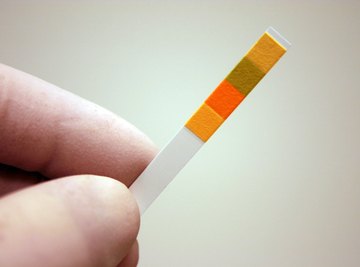
All life on the planet is made up of four basic chemicals; carbohydrates, lipids, proteins, and nucleic acids. At the core, all four of these molecules contain carbon and hydrogen and are part of a branch of science called biochemistry that mixes biology and organic chemistry. While the four categories have some similarities, the inclusion of different groups of atoms, called functional groups, completely changes the function of the chemical. While many of these functional groups have no effect on pH, some of these functional groups can shift the pH of the fluids in an organism. Maintaining a pH is vital to an organisms well being so it is important to know how these functional groups interact.
Definition of Acids and Bases
Acids and bases are opposing parts of a sliding scale known as pH. The pH scale measures the amount of positive hydrogen ions, henceforth H+, that are in a solution in relation to the amount of hydroxide ions, labeled OH-. The midpoint of the scale is pH7 and at pH7, the amount of H+ ions and OH- ions are in complete balance. The overall pH scale ranges from zero through fourteen. Anything that adds H+ ions to solution is called an acid and it shifts the pH lower. Therefore, any pH from 0-6.9 is considered acidic. Anything that donates OH- to solution or binds the H+ ions is considered a base and raises the pH making pH 7.1 - 14 basic. The farther the shift from 7 the pH is, the more damaging a substance can be in either direction. Stomach acid is pH 2, which is an extremely strong acid and lye is an extremely strong base for reference.
Non-acidic Functional Groups
Most functional groups have little to no effect on the acidity of the molecule. The ketone has no hydrogens to donate to solution or places to accept hydrogen. The hydroxyl, which is simply an OH attached to the molecule, could conceivably lose it's hydrogen, making it acidic, but that is not how the molecule normally interacts. An aldehyde has a hydrogen to lose but it is connected to a carbon molecule and carbon never likes to drop its hydrogens. Lastly, the sulfhydryl, which is an SH attached, more often likes to find other sulfhydryls to bond with as opposed to donating hydrogen to the solution. Therefore, none of these groups are usually associated with having an acidity level.
Carboxyl
The carboxyl functional group is often referred to as an acid group because it is very acidic. Oxygen has a very high electronegativity, which means it likes to hoard electrons. The with the OH on the end of the carboxy, the double bonded oxygen usually offers assistance in hoarding the electrons and the hydrogen that is attached simply falls off into solution, lowering the pH. Carboxyl groups are found in fatty acids, which form fats, oils, and waxes when combined with other molecules. Carboxyls are also part of amino acids which are the building blocks of proteins.
Phosphate
The phosphate group can donate up to two hydrogens per molecule making it very acidic as well. As stated before, oxygen has a high electronegativity and one look at a phosphate molecule shows that there are four oxygens surrounding the phosphate molecule. Those four oxygens are going to try and pull the electrons that are being shared with the two OH bonds and the two hydrogens usually lose and fall off into solution as H+ ions, lowering the pH.
Amino
The other half of amino acids are the amino groups. Nitrogen often functions as a hydrogen acceptor in biological systems. In its normal state, the amino group exists as a nitrogen and two hydrogens, as shown here, but it can accept another hydrogen from solution which causes the pH of the system to raise, making it more basic. Since the backbone of all amino acids is a carboxyl, a carbon with a different functional group, and an amino group, what usually happens is that the carboxyl donates its hydrogen to solution but the amino group accepts a hydrogen from solution making the overall pH stay the same.
References
About the Author
Matthew Williams has his Bachelor's degree in biology with a minor in chemistry and also holds his Master's degree in Secondary Education. While concurrently working on two more Master's degrees, he teachers advanced biology at the high school level full time. His major passion is music and he has played numerous instruments over the past 20 years, including piano, guitar, bass
